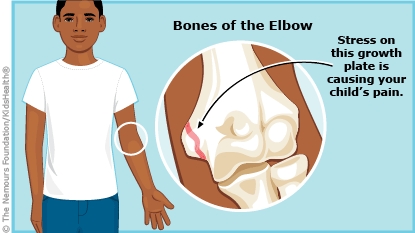Medial Epicondyle Apophysitis: How to Care for Your Child
With rest and pain relief, medial epicondyle apophysitis gets better on its own.


Medial epicondyle apophysitis is an overuse injury caused by stress on the growth plate of a bone in the elbow. Growth plates are areas at the end of a bone that allow it to grow.
This injury is most common in kids between the ages of 8 and 15 while the growth plates are still active. Repeatedly making an overhand throwing motion (as in pitching, throwing a football, or striking a volleyball) can cause inflammation in the growth plate. In more advanced stages, there may be small fractures of the growth plate.
The health care provider diagnosed your child by examining the elbow and asking about sports activity. X-rays were taken to help diagnose the problem, but X-rays are often normal in mild cases of medial epicondyle apophysitis.
Pain relief and rest is the main treatment, although your health care provider may also recommend physical therapy. Your child will need to stop pitching or throwing for about 4–6 weeks. A slow return to throwing will be needed, and it can take up to 12 weeks to get back to pitching in a game.

-
Your child does not need to give up all sports, but does need to stop all throwing until the elbow gets better. Talk to your health care provider about sports that will help maintain fitness and body strength while resting the elbow.
-
For pain and inflammation, you may give acetaminophen, ibuprofen, or other similar medications (such as naproxen), if recommended by the health care provider.
-
Place cold compresses or ice wrapped in a towel over the elbow for 20 minutes every 3–4 hours to lessen pain and swelling. Do not place ice directly on the skin.

Your child:
-
Has pain that doesn't improve with pain medications, rest, or ice.
-
Has pain that is not related to activity or becomes worse at night.

Your child:

It is most important to prevent medial epicondyle apophysitis from returning. Once your child returns to pitching or throwing, there should be limits on pitches per game and breaks from throwing from time to time. Work with coaches to be sure your child also has proper throwing mechanics.